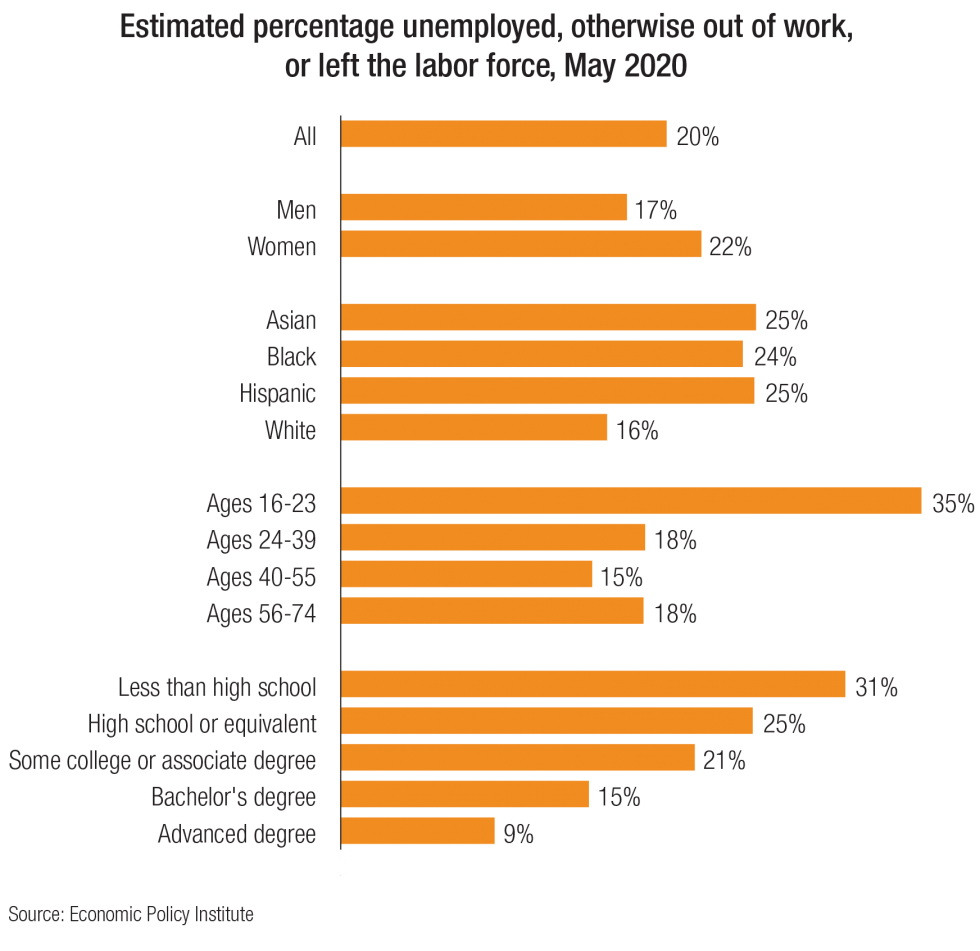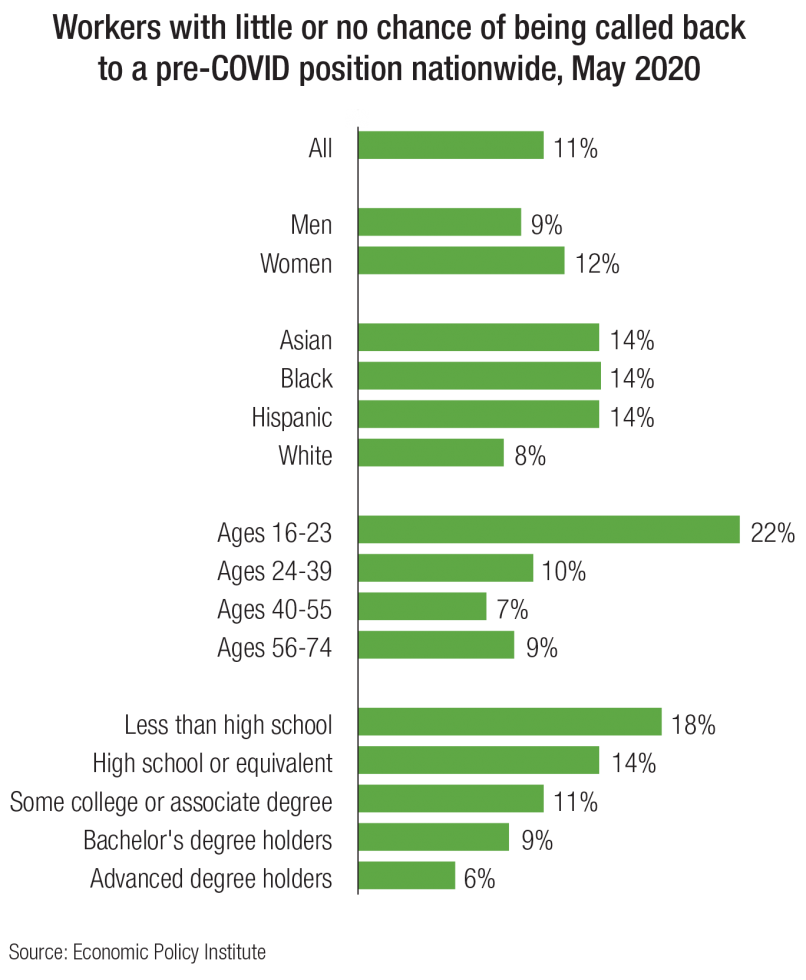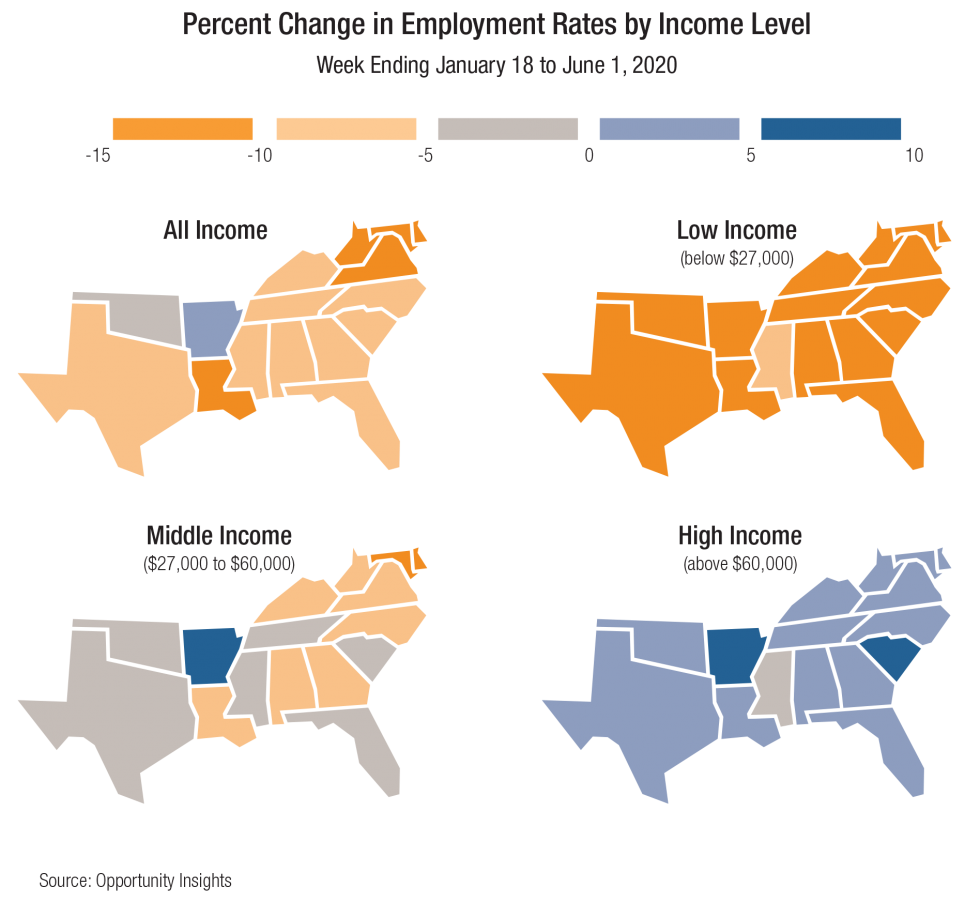The Pandemic’s Dual Threat for Vulnerable Workers
Accelerated automation and post-pandemic impacts could displace millions
Key Findings
- By 2025, nearly one-third of work activities could be automated across the SREB region.
- Nearly two-thirds of the region’s workers have a high school diploma or less and are significantly more vulnerable to automation.
- Official unemployment rates may underestimate real impacts.
- Risk during COVID-19 is higher for low-income workers and other traditionally vulnerable groups.
Download a PDF of this brief
Since January 20, 2020, the day the first COVID-19 case was recorded in the United States, state and industry leaders have been riding a roller coaster of social and economic fluctuations. In the short term, businesses shut their doors, forcing millions of workers onto unemployment while others began teleworking for the first time. Consumer preferences and behaviors changed, too, with a dramatic increase in online shopping and socializing. Students of all ages finished the 2019-20 school year in virtual classrooms or with no instruction at all.
Moving into winter, states are finding that some impacts from early 2020 are long-lasting — and others permanent. Countless small businesses didn’t survive. Unemployment remains high and millions of workers are missing from the labor force. Education leaders continue struggling to meet the needs of students and teachers, balancing these with parents’ concerns about safety and childcare. The enduring effects of the pandemic are not yet fully realized and will vary across industries and states. But one thing is clear: for the nation’s vulnerable workers — especially the oldest and youngest, those without postsecondary education, women, and Black, Hispanic and Asian workers — the pandemic poses a double threat.
First, COVID-19 shutdowns accelerated the Fourth Industrial Revolution — trends already well underway in automation, artificial intelligence, smart devices and virtual reality. Before the pandemic, SREB’s Economic Outlook profiles helped states gauge industry automation potential to estimate how many adults are vulnerable to displacement and might need reskilling for future positions. The profiles warned that 18 million low-skilled workers across the region could be unemployable or stuck earning poverty wages by 2030 if they didn’t raise their skills. The pandemic has accelerated these estimates. Now, those 18 million workers in the South could be at risk by 2025.
Second, worker vulnerability has been exacerbated by the pandemic, especially as low-skilled employees tend to concentrate in industries more heavily impacted by shutdowns and ongoing public health restrictions — often the same industries with higher automation potential. Despite millions of workers being declared essential or able to work from home during the pandemic, thus highly unlikely to be out of work, millions more lost hours, lost jobs or had to leave the workforce. Many of these are not captured in official unemployment counts, meaning state leaders are likely underestimating the impacts of the pandemic on their workforces — impacts both from automation and from COVID-19 itself.
The pandemic creates enormous challenges, but it also offers an unprecedented opportunity for states to update education, bolster resilient workforces, and pass policies that support healthy families and thriving economies.
The need for action to prepare today’s workforce for tomorrow’s possibilities could not be more urgent. The pandemic creates enormous challenges, but it also offers an unprecedented opportunity for states to update education, bolster resilient workforces, and pass policies that support healthy families and thriving economies. If states can meet this moment, what they stand to gain is worth the effort. If states do not rise to the challenge, preparing their workforces for tomorrow’s uncertainties, the fallout for individuals and industries could be catastrophic.
The Pandemic Accelerates Automation Potential by Five Years
A 2017 McKinsey & Company analysis of automation potential explained that rather than whole jobs going away, it is more likely that certain aspects of jobs, or work activities, will be automated. Based on McKinsey’s projections, SREB reported that 44% of all work activities were potentially automatable from 2016 to 2030. As with most everything else, the pandemic altered these estimates. In May 2020, McKinsey and Company found that consumer and business digital adoption had advanced five years (by McKinsey’s previous projection) over just eight weeks at the beginning of the pandemic.
Businesses and individuals moved to digital platforms at unprecedented rates. In fact, across industries, three-quarters of people who began using any new digital channel reported they would continue using it after the pandemic. Corporations have reported, too, that shifts to virtual operations will be — at least partly — permanent. And with future safety protocols still uncertain, consumer services, transportation, information technologies, sales, marketing and other industries are transforming in comprehensive ways. Fluctuation in one industry inevitably causes upsets in others.
To assess prospective COVID-accelerated digital advancement and update the Economic Outlook profiles, SREB again used McKinsey’s 2017 automation projections. SREB assumed that the same percentage of activities would be automated over each of the 15 years from McKinsey’s analysis — 2016-2030 — and then condensed the last 10 years (from 2021 to 2030) into five. Adoption potential is stated as a percentage of (2016) work activities automatable with technologies available at the time of the original analysis.
Of course, uniform technology adoption over years is unlikely. Adoption speeds up over time as new technologies pave the way for still newer ones, meaning that even estimates of full (2016) potential could be conservative as they do not consider more recent technologies and employment statistics. General projections for the 2020s and 2030s include ever-quickening automation that could essentially wipe out whole industries, at least as we know them today. But in just the next five years, 30% of all work activities across the region could be automated, devastating workers and businesses that are unprepared. In fact, according to the World Economic Forum, by 2025 humans and machines will equally share the time spent performing tasks in the workplace.
Keep in mind that many work activities were already automated between 2016 and 2020, and that this analysis looks forward to adoption potential over the next five years. Automation potential varies by industry, so for each state SREB reports automation potential in the top five industries (those that employ the most workers). Just over half of the region’s workers are employed in a top-five industry in their state.
In all SREB states, food preparation, sales, and office and administrative industries are top employers. Others include transportation (14 states), production (11), healthcare (4) and business operations (1). SREB estimates that 42% or more of work activities in food, transportation, education, and office and administrative occupations across the region could be automated by 2025. Approximately 28% of sales activities and 58% of production activities could be automated as well. While mechanizing and computerizing so many work activities will likely transform more positions than it eliminates, there are still thousands of workers who could lose their jobs as technology advances.
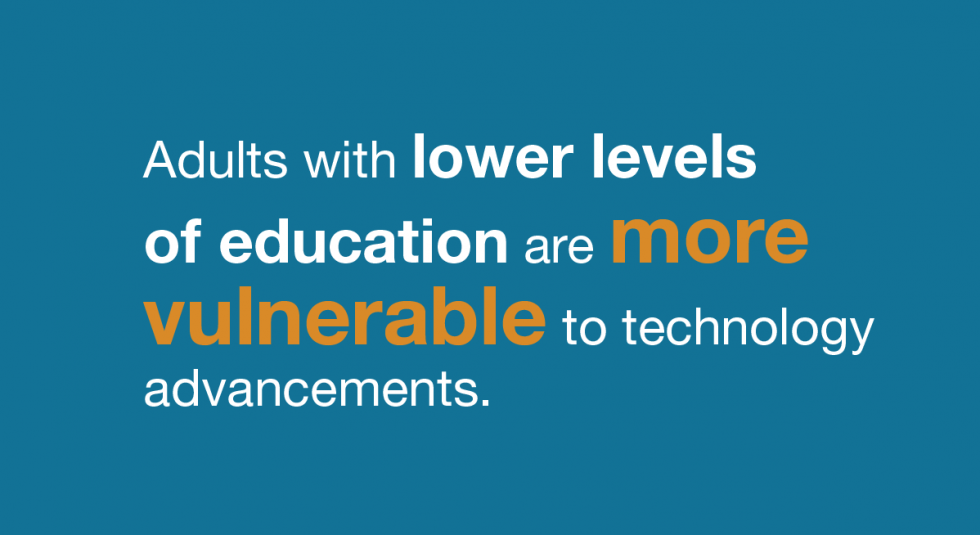
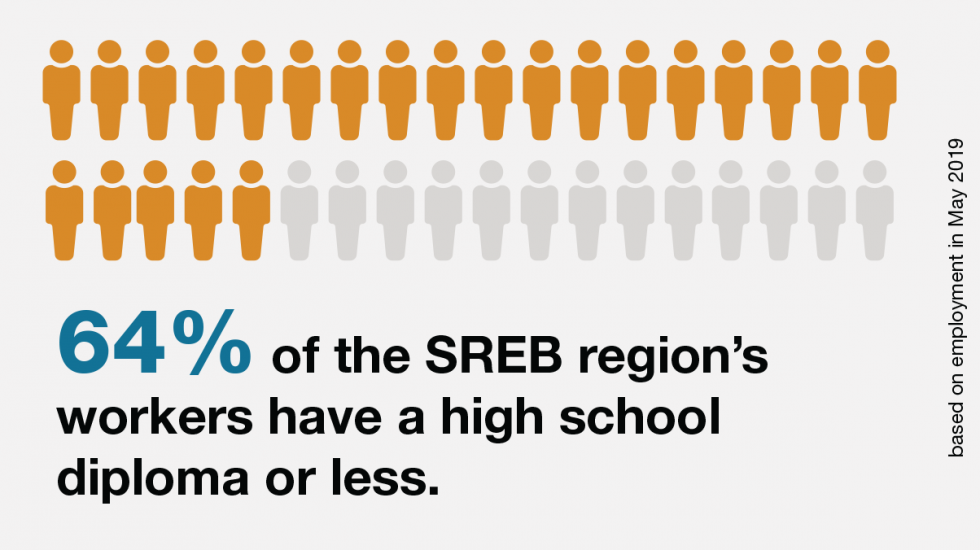 Again, advancing technology will create new positions, but as SREB’s Unprepared and Unaware explained, low-skilled adults with high school diplomas or less are increasingly likely to be unemployable or stuck in low-wage jobs if they don’t raise their education level. By May 2019, 64% of active employees across the SREB region — 33.6 million workers — had a high school diploma or less. This means nearly two-thirds of the region’s employees are at risk for job displacement, layoffs and unemployment, especially during the pandemic. For those who remain in their current positions, the World Economic Forum estimates that 40% of their share of core skills will change in the next five years and 50% of all employees will need reskilling.
Again, advancing technology will create new positions, but as SREB’s Unprepared and Unaware explained, low-skilled adults with high school diplomas or less are increasingly likely to be unemployable or stuck in low-wage jobs if they don’t raise their education level. By May 2019, 64% of active employees across the SREB region — 33.6 million workers — had a high school diploma or less. This means nearly two-thirds of the region’s employees are at risk for job displacement, layoffs and unemployment, especially during the pandemic. For those who remain in their current positions, the World Economic Forum estimates that 40% of their share of core skills will change in the next five years and 50% of all employees will need reskilling.
An increase in postsecondary credentials will be critical not only for workers but for states, which need to maintain highly educated workforces if they hope to attract the types of businesses that employ them. Jobs created by technology advancement often emerge in industries and geographies different than those from which they disappear. Businesses are more likely to expand into areas that already have a ready workforce. As The SREB Region’s Economic Outlook pointed out, since the South already lags the nation in adult educational attainment, it may be more likely to attract businesses that don’t rely on workers with postsecondary education — in the process offering more lower-wage positions.
Unemployment Risk Increases During Pandemic
We know that automation potential varies by industry, and we’ve seen that some industries with higher automation potential are also more severely impacted during the pandemic. Customer-facing positions like food service and retail jobs are more likely to be affected by automation and the pandemic than others, such as management and social service positions. To assess industry workers’ vulnerability due to COVID-19, the Federal Reserve Bank of St. Louis classified all 808 occupational codes in the U.S. Bureau of Labor Occupational Employment Statistics based on three criteria:
- whether the occupation was essential to public health or safety
- whether the occupation was likely able to be performed off site
- whether that occupation was likely to be salaried
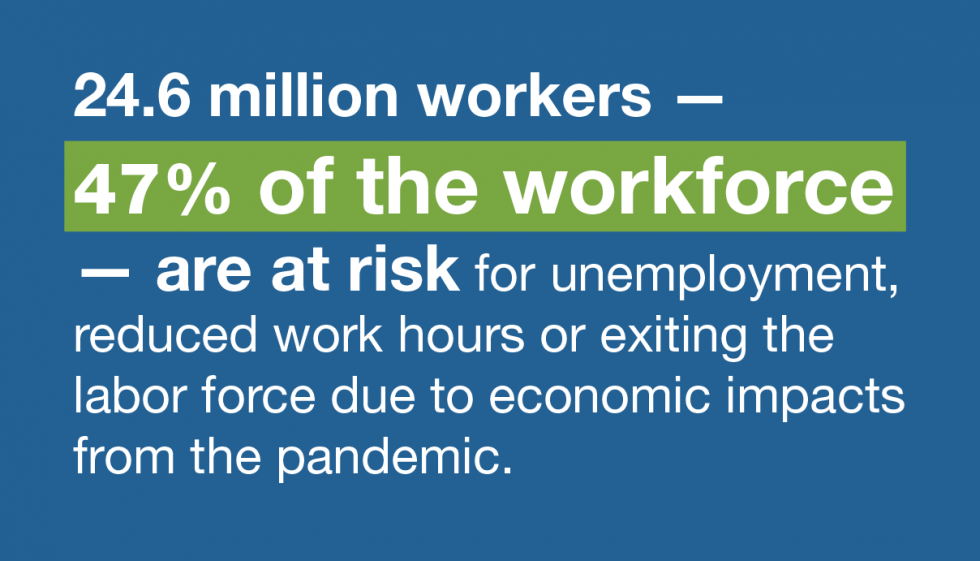 By comparing this risk classification system with May 2019 state industry employment numbers, SREB estimates that 32% of employees can likely work from home while 17% of the region’s workforce — close to 9 million workers — are considered essential to public health and safety. However, another 24.6 million workers are at high risk for unemployment during the pandemic, ranging from 41% to nearly 52% of states’ workforces.
By comparing this risk classification system with May 2019 state industry employment numbers, SREB estimates that 32% of employees can likely work from home while 17% of the region’s workforce — close to 9 million workers — are considered essential to public health and safety. However, another 24.6 million workers are at high risk for unemployment during the pandemic, ranging from 41% to nearly 52% of states’ workforces.
Four of the top five industries in the SREB region — production, transportation, sales, and food preparation and serving — employ the highest percentage of workers vulnerable due to the pandemic, and in three of these industries automation potential is also high, with over 60% of activities potentially automatable.
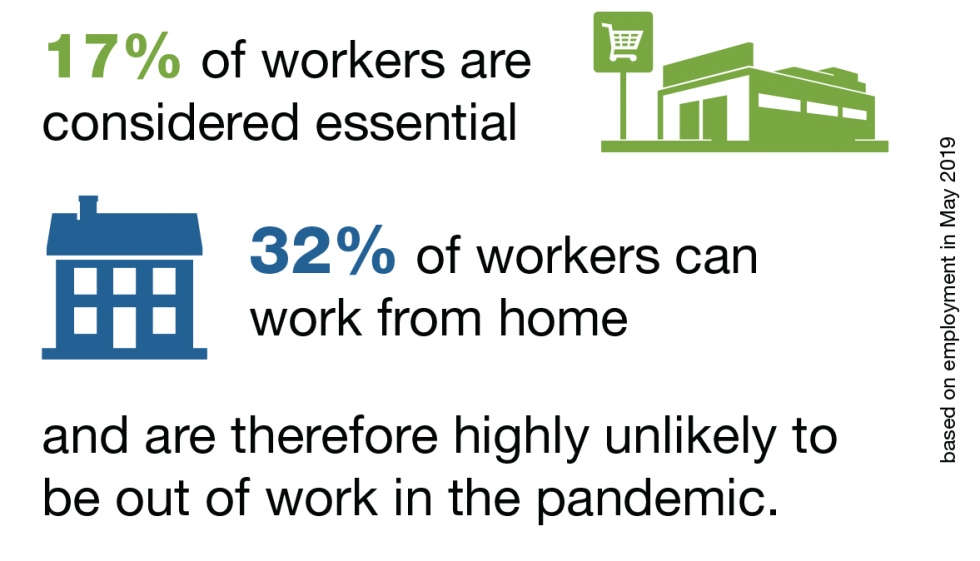 Food preparation, for example — with one of the highest automation potentials at 69% — employs 10% of the SREB region’s workers, and every employee in this industry is vulnerable. Similarly, production occupations that employ almost 6% of the region’s workers have an automation potential of 86%, and in the 13 SREB states where production is a top-five employer over 83% of workers are at risk during the pandemic. With ongoing concerns about virus transmission, consumer habits will remain altered for quite some time, and shifts in consumer habits and safety concerns mean lasting, possibly permanent shifts for large portions of the workforce.
Food preparation, for example — with one of the highest automation potentials at 69% — employs 10% of the SREB region’s workers, and every employee in this industry is vulnerable. Similarly, production occupations that employ almost 6% of the region’s workers have an automation potential of 86%, and in the 13 SREB states where production is a top-five employer over 83% of workers are at risk during the pandemic. With ongoing concerns about virus transmission, consumer habits will remain altered for quite some time, and shifts in consumer habits and safety concerns mean lasting, possibly permanent shifts for large portions of the workforce.
Other industries, although not top employers, still have large portions of workers who are vulnerable due to the pandemic. The installation/maintenance and construction/extraction industries together comprise 8% of the total SREB workforce. Over 99% of workers in installation occupations are at risk during the pandemic, as are 87% of construction workers. SREB reports worker vulnerability due to COVID-19 as the percentage of at-risk workers in the five industries that employ the highest numbers of vulnerable workers.
Official Unemployment Rates May Underestimate Real Impacts
When COVID-19 case numbers began climbing and businesses shut down, unemployment claims skyrocketed, reaching their highest numbers in April. By the first day in June all but two SREB states had either ended stay-at-home orders or released restrictions on business operations, so May sets a good low-point from which to gauge states’ recoveries — and doing so may help states estimate the extent of hidden impacts on workers.
By May 2020, 21 million workers nationwide were classified as unemployed by the U.S. Bureau of Labor Statistics. But the Economic Policy Institute cautioned that an additional 11.5 million were out of work, not captured in the unemployment rate because they were furloughed or temporarily laid off, gig workers or independent contractors, or had left the labor force altogether.
If these workers had been included, EPI estimates, the percentage of people unemployed nationwide in May 2020 would have been closer to 19.7% than the BLS 13.3%. To estimate the full scope of unemployment impacts in the region, we assumed that each state had the same percentage of uncounted workers as those EPI estimated at the national level. SREB estimates that an additional 3.1 million workers in the South were likely laid off, had their hours cut, or dropped out of the labor force. So the median unemployment rate of the 16 SREB states might have been 17.3% instead of 11.7%.
Over half of those who were out of work in May 2020 had little or no chance of being called back to their pre-pandemic positions.
EPI estimated that over half of those who were out of work in May 2020 had little or no chance of being called back to their pre-pandemic positions. This translates to 5.5 million workers across the SREB region. And this could be a low estimate, as SREB states have both higher percentages of adults with no postsecondary education than the nation as a whole and higher concentrations of workers in industries that are vulnerable to automation.
Risk During COVID-19 is Higher for Traditionally Vulnerable Workers
These factors — education, income, gender, age and race — compound with others to leave workers vulnerable in more ways than one.
Before COVID-19, we knew that adults with low levels of education were vulnerable to automation-related workforce shifts and that these low-skilled adults are more often younger, Black and Hispanic, and lower-income earners. We also knew that low-skilled adults tend to be overrepresented in industries vulnerable to automation. In addition to these, women and older workers are more vulnerable to labor shifts, especially during the pandemic. Women are more vulnerable partly because they dominate some industries that rely on more face-to-face interactions, partly because they tend to carry more of the responsibility of child-rearing. Older and younger workers are more at risk because of factors that include their education levels, the positions they tend to hold, and their adaptability to new technologies.
These factors — education, income, gender, age and race — compound with others to leave workers vulnerable in more ways than one. Predictably, they lost work hours and left the workforce during the pandemic at much higher rates than their more educated, white, male and higher-income-earning counterparts. And their prognosis in the recovery is similarly bleak. COVID-19 has intensified the need for support and retraining, and states will need to be flexible in developing creative and far-reaching solutions to adequately meet the expanding and evolving needs of these vulnerable workers.
According to the Economic Policy Institute, for workers 16 and older who were out of work nationwide in May 2020, the following unemployment discrepancies were observed:
The likelihood of being called back to a prior position varied by demographic group as well, but in the same pattern. Younger, less educated, non-white and female workers were at greater risk for permanent job loss:
Low-Income Workers are Hit Hardest
Researchers at Opportunity Insights, a non-partisan non-profit based at Harvard University, note that the nationwide employment rate decreased by 11.2 percentage points between January 18 and June 1, 2020, but low-income workers experienced significantly higher job losses. Their analysis reveals that in the first five months of 2020, the median employment rate for SREB states decreased by 7.8 points for all workers. For low-income workers — earning under $27,000 — the drop was 18 points. For workers earning between $27,000 and $60,000, employment decreased by 5.8 percentage points over the same period, while for workers earning above $60,000, employment actually increased in 14 SREB states, with a median regional gain of 3.4 points.
If States Don’t Catch Up Now, Then When?
States will need to work vigorously to address the challenges facing their residents, especially the most vulnerable among them, not just to meet them today but to prepare for tomorrow. Workers need access, now more than ever, to additional training and education as well as additional support to make use of the opportunities available. The economic effects of the COVID-19 pandemic have increased the need for nimble responses to rapidly changing workforce needs. But while businesses can often maneuver quickly, education historically does not.
The pandemic has created an opportunity — even a necessity — to rethink and redesign education in the United States. Now, perhaps more than at any time previously, states must be swift, thorough and creative if they hope to meet the mounting needs of an unprepared workforce. The decisions leaders make in the coming weeks and months will have far-reaching impacts that can support or hinder progress in their states for years to come.
The Pandemic’s Dual Threat for Vulnerable Workers brief in PDF format
SREB Resources on Workforce, Education and COVID-19 Response
SREB has been working to help states meet the challenges created and exacerbated by the pandemic, not just in the workforce but at all levels of education, working to ensure a brighter future for SREB residents. We believe that education and the workforce must improve together, not separately but as a seamless system.
COVID-19 Response resources, including K-12 and Higher Education Recovery Playbooks and Task Forces at https://www.sreb.org/covid-19
Bouncing Back From COVID-19 Using Education and Workforce Dollars webinar series at https://www.sreb.org/past-webinars
CTE and Career Pathways resources, including publications Designing a Ready Workforce and Shared-time Technology Centers at https://www.sreb.org/CTE
Workforce and Education resources, including referenced publications Unprepared and Unaware and The Region’s Economic Outlook at https://www.sreb.org/Workforce
Teacher Workforce Policy resources, including information on COVID-19 effects on the teacher workforce at https://www.sreb.org/TeacherWorkforce
Appendix A
Employment Rate Change
January 18 – June 1, 2020
|
|
Total |
Low-Income (below $27,000) |
Middle ($27,000 to $60, 000) |
High (above $60,000) |
|
United States |
-11.2 |
-23.2 |
-11.1 |
-1.1 |
|
SREB Median |
-7.8 |
-18.1 |
-5.8 |
3.4 |
|
Alabama |
-6.9 |
-15.7 |
-5.2 |
4.3 |
|
Arkansas |
1.4 |
-10.9 |
8.4 |
9.6 |
|
Delaware |
-12.0 |
-27.6 |
-11.4 |
1.5 |
|
Florida |
-7.2 |
-19.1 |
-4.8 |
2.9 |
|
Georgia |
-8.3 |
-20.2 |
-7.0 |
3.7 |
|
Kentucky |
-9.1 |
-18.9 |
-6.8 |
3.8 |
|
Louisiana |
-12.5 |
-23.0 |
-8.3 |
-1.1 |
|
Maryland |
-11.5 |
-28.8 |
-11.3 |
1.5 |
|
Mississippi |
-5.8 |
-9.5 |
-2.6 |
-0.5 |
|
North Carolina |
-8.9 |
-20.1 |
-6.4 |
3.0 |
|
Oklahoma |
-4.3 |
-12.4 |
-2.9 |
4.7 |
|
South Carolina |
-6 |
-16.2 |
-4.2 |
5.1 |
|
Tennessee |
-5.1 |
-15.5 |
-2.3 |
4.4 |
|
Texas |
-6.5 |
-16.5 |
-4.4 |
1.2 |
|
Virginia |
-10.1 |
-23.9 |
-10.0 |
3.7 |
|
West Virginia |
-10.7 |
-17.2 |
-9.5 |
0.3 |
Source: Opportunity Insights, accessed August 19, 2020
References
Baig, A., Hall, B., Jenkins, P., Lamarre, E., & McCarthy, B. (May 2020). The COVID-19 recovery will be digital: A plan for the first 90 days. McKinsey & Company. Retrieved from https://www.mckinsey.com/business-functions/mckinsey-digital/our-insights/the-covid-19-recovery-will-be-digital-a-plan-for-the-first-90-days
Bureau of Labor Statistics. (March 31, 2020). May 2019 OES Estimates. Retrieved from https://www.bls.gov/oes
Bureau of Labor Statistics. (June 25, 2020). Unemployment rates down over the month in 38 states in May 2020. The Economics Daily. U.S. Department of Labor. Retrieved from https://www.bls.gov/opub/ted/2020/unemployment-rates-down-over-the-month-in-38-states-in-may-2020.htm
Bureau of Labor Statistics. (2020). Economy at a Glance. Retrieved from https://www.bls.gov/eag/eag.us.htm
Chetty, R., Friedman, J. N., Hendren, N., Stepner, M., and the Opportunity Insights Team. (June 17,2020). How Did COVID-19 and Stabilization Policies Affect Spending and Employment? A New Real-Time Economic Tracker Based on Private Sector Data. Opportunity Insights. Retrieved from https://tracktherecovery.org/
Gascon, Charles. (March 2020). COVID-19: Which Workers Face the Highest Unemployment Risk? Federal Reserve Bank of St. Louis. Retrieved from https://www.stlouisfed.org/on-the-economy/2020/march/covid-19-workers-highest-unemployment-risk
Gascon, Charles. (April 3, 2020). COVID-19 and Unemployment Risk: State and MSA Differences. Federal Reserve Bank of St. Louis. Retrieved from https://www.stlouisfed.org/on-the-economy/2020/april/covid-19-unemployment-risk-state-msa-differences
McKinsey Global Institute. (October 1, 2018). Automation and US Jobs. Retrieved from https://public.tableau.com/profile/mckinsey.analytics#!/vizhome/AutomationandUSjobs/USAutomationlandscape
Occupational Employment Statistics. (March 31, 2020). Implementing the 2018 SOC in the OES program – May 2019 and May 2020 Hybrid Occupations. Retrieved from https://www.bls.gov/oes/soc_2018.htm
Opportunity Insights. (2020). Economic Tracker [Interactive Chart]. Retrieved on August 19,2020 from https://tracktherecovery.org/
Perry, M. J. (September 11, 2019). Explaining US income inequality by household demographics, 2018 update. AEIdeas. https://www.aei.org/carpe-diem/explaining-us-income-inequality-by-household-demographics-2018-update/
Shierholz, H. (June 29, 2020). Nearly 11% of the workforce is out of work with no reasonable chance of getting called back to a prior position. Economic Policy Institute. https://www.epi.org/blog/nearly-11-of-the-workforce-is-out-of-work-with-zero-chance-of-getting-called-back-to-a-prior-job/
Southern Regional Education Board. (2019). Unprepared and Unaware: Upskilling the Workforce for a Decade of Uncertainty. Atlanta, GA: Southern Regional Education Board.
Southern Regional Education Board. (2019). The SREB Region’s Economic Outlook. Atlanta, GA: Southern Regional Education Board.
World Economic Forum. (October 20, 2020). The Future of Jobs Report 2020. Retrieved from https://www.weforum.org/reports/the-future-of-jobs-report-2020







